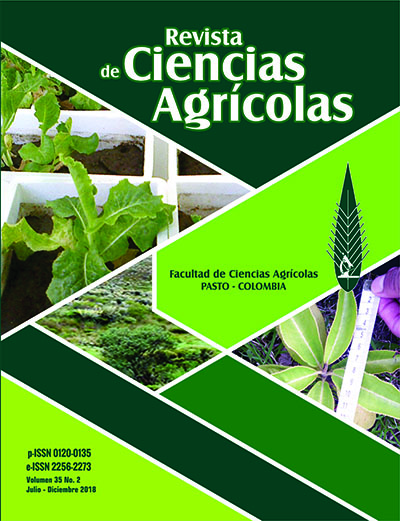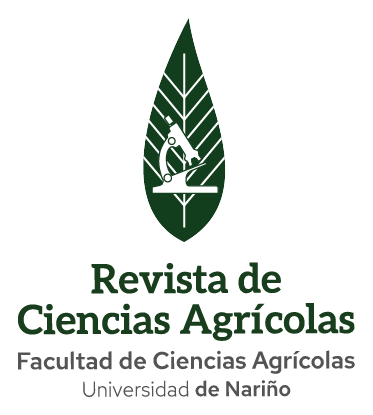Effect of the application of copolymere on lettuce (Lactuca sativa L.) crop
DOI:
https://doi.org/10.22267/rcia.183502.89Keywords:
Acrilamyde, potassium acrylate, Hydrogel, yieldAbstract
The main problem of the agricultural production in arid and semiarid regions is mainly the scarcity of irrigation water and the low quality of the soils. Hence, it is important to find alternatives and efficient water resources management practices in these regions within a frame of absolute rationality and sustainability. The objective of this work was to assess the water retention capacity of acrilamyde copolymer and potassium acrylate and how these could improve a lettuce crop (Lactuca sativa L.) implantation and growth under controlled conditions. Two treatments with 25 and 50 kg. ha-1 doses versus a control sample were compared in order to determine if the use of said amendment could improve crop production. The emergence, survival, fresh and dry weight of the aerial part of the crop and the soil humidity levels were evaluated. The answers were positive for the application of the amendment in the lower dose since the emergence of seedlings, its survival, its growth and its consequent yield raised, as well as the moisture content of the soil. In conclusion, the application of 25 kg ha-1 of the copolymer in the of the lettuce crop site, improved the growth and increased its yield.
Downloads
Metrics
References
Barreto, N. (2011). Evaluación del efecto de retenedores de agua en el establecimiento de Juniperus fláccida Schlechtendal en Ixcateopán, Gro. Chapingo México: Universidad Autónoma de Chapingo. 55p.
Brito, C., Rodrigues, F., Fernandes, M., Da Silva, L., Ricardo, N., Feitosa, J. & Muniz, E. (2013). Síntese e caracterização de hidrogéis compósitos a partir de copolímeros acrilamida-acrilato e caulim: efeito da constituição de diferentes caulins do nordeste brasileiro. Química Nova. 36(1): 40-45.
Chatzopoulos, F. Fugit, J., Ouillon, I., Rodriguez, F. & Taverdet, J. (2000). Étude, en fonction de différents paramètres, de l’absorption et de la désorption d’eau par un copolymère acrylamide–acrylate de sodium réticulé. European Polymer Journal, 36(1): 51-60.
Di Rienzo, J., Casanoves F., Balzarini M., Gonzalez L., Tablada M. & Robledo C. (2008). InfoStat, versión 2008, Grupo InfoStat, FCA, Universidad Nacional de Córdoba, Argentina.
Dranski, J., Pinto Júnior, A., Campagnolo, M., Malavasi, U., Malavasi, M. & Guimarães, V. (2013). The effect of planting season and hydrogel on survival and initial growth of physic nut. Ciência Florestal. 23(3): 489-498.
García, A. & Fuentes, V. (1994). Cultivos en zonas áridas: Características que mejoran sus rendimientos y uso eficaz del agua. Edición III. Murcia: Universidad de Murcia.316p.
González, C.A. (2009). Contenido de humedad del agua del suelo. Unidad 2. R.A.S.P.A. Relación Agua, Suelo, Planta, Atmósfera. Bogotá: Universidad Nacional de Colombia. 8p.
Irurtia, C., Mon, R., Holzmann, R. & Pirolo, T. (2012). Efecto de la poliacrilamida en las propiedades físicas de un suelo arenoso. Recuperado de https://www.engormix.com/agricultura/articulos/efecto-poliacrilamida-propiedades-fisicas-t31202.htm
ISO 11465 (1993). Soil quality. Determination of dry matter and water content on a mass basis-Gravimetric method. Primera edición. Berlin: Deutsches Institut für Normung. 3p.
ISTA (International Seed Testing Association. (2014). International rules for seed testing 2014. International Seed Testing Association. Zürich, Switzerland. 5-24.
Killian, S. (2010). Introducción a la Fisiología Vegetal. Argentina: Editorial Científica Universitaria, Universidad Nacional de Catamarca. 109-165p.
Lópes, J., Da Silva, M., Saad, J. & Angélico, T. (2010). Use of hydrogel in the survival of cuttings of eucalyptus urograndis produced with different types of substrate and water management. Ciencia Florestal. 20(2): 217-224.
López-Elías, J., Huez, M., Rueda, E., Jiménez, J., Cruz, F. & Garrido, O. (2013). Uso de un polímero hidrófilo en chile Anaheim (Capsicum annuum L.) bajo condiciones de invernadero. Idesia. 31(2): 77-81. doi: http://dx.doi.org/10.4067/S0718-34292013000200011
Magalhães, A., Almeida, M., Bezerra, M. & Feitosa J. (2013). Superabsorbent Hydrogel Composite with Minerals Aimed at Water Sustainability. J. Braz. Chem. Soc. 24(2): 304-313. doi: http://dx.doi.org/10.5935/0103-5053.20130039
Marques, T., Dos Santos, A. & Marques, P. (2013). The hydrogel polymer and depth of planting in sugarcane production. IRRIGA. 18(1): 126-138. doi: http://dx.doi.org/10.15809/irriga.2013v18n1p126
Nissen, M. & Ovando, C. (1999). Efecto de un hidrogel humectado aplicado a las raices de Nothofagus obliqua (MIRB.) Oerst. y Nothofagm dombeyi (MIRB.) Oerst. Durante su trasplante. Agro sur. 27(2): 48-58.
Pedroza-Sandoval, A., Yáñez-Chávez, L., Sánchez-Cohen, I. & Samaniego-Gaxiola, J. (2015). Efecto del hidrogel y vermicomposta en la producción de maíz. Revista fitotecnia mexicana. 38(4): 375-381.
Trujillo, E. (2009). Plantines y retenedores de agua. Edición Especial. Revista el Semillero. 25-27.



























